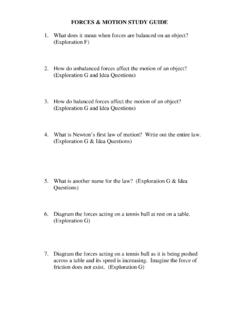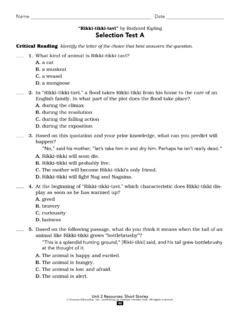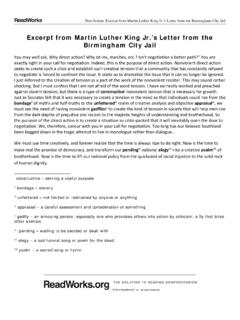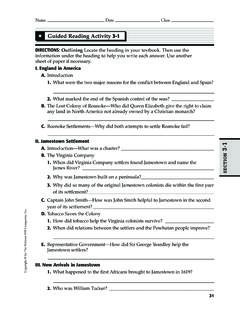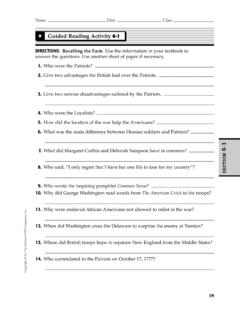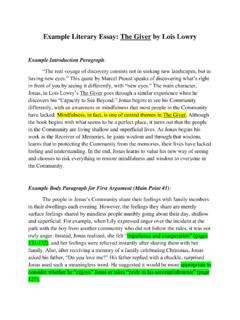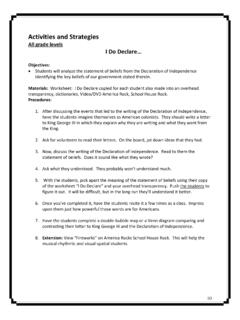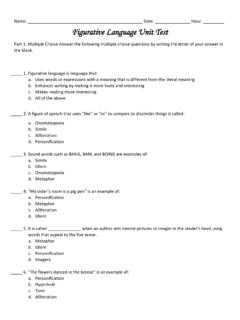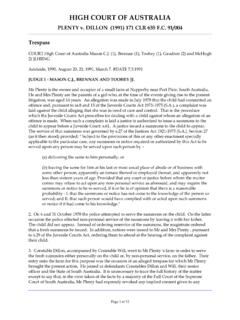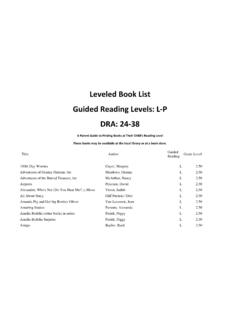Transcription of Seasons of Want and Plenty - Moore Public Schools
1 Seasons of want and Plenty by historian William Cronon* _____ ..In describing New England s natural abundance so enthusiastically, the colonists were misleading in two Those [like Morton] who sought to promote colonial enterprises tended to put the best possible face on everything they encountered in the New World. Selective reporting, exaggeration, and outright lies could all be useful tools in accomplishing this When English immigrants exaggerated the [natural] wealth of New England, they dreamed of a world in which returns to human labor were far greater than in England. Because their hopes led them to expect a land of Plenty , early visitors introduced a second distortion into their accounts. Even when what they wrote was literally true, they often failed to note that it was not always Most early descriptions were written by spring and summer visitors, who naturally saw only the times when fish, fruit, and fowl were all too numerous to count.
2 Would-be English settlers thus formed their vision of New England from accounts that concentrated the summer s seasonal wealth into an image of perpetual In New England, most colonists anticipated that they would be able to live much as they had done in England, in an artisanal and farming community with work rhythms, class relations, and a social order similar to the one they had left behind the only difference being their own improved stature in society. There were many misconceptions involved in this vision, but the one most threatening to survival was the simple fact that establishing European relations of production in the New World was a far more complicated task than most colonists realized. Even to set up farms was a Many colonists arrived believing that they could survive until their first harvest simply by living as the Indians supposedly did, off the unplanted bounties of nature.
3 Colonists were assured by some that Indian men got their livelihood with small labour but great pleasure.. The willingness of colonists to believe such arguments, and hazard their lives upon them, was testimony to how little they understood both the New England environment and the ways Indians actually lived in it. A central fact of temperate ecosystems like those of New England is their periodicity: they are tied to overlapping cycles of light and dark, high and low tides, waxing and waning moons, and especially the long and * Adapted from William Cronon, Changes in the Land: Indians, Colonists, and the Ecology of New England, 20th anniversary ed. (New York: Hill and Wang, 2003), 34-53.
4 Short days which mean hot and cold Just as a fox s summer diet of fruit and insects shifts to rodents and birds during the winter, so too did the New England Indians seek to obtain their food wherever it was seasonally most concentrated in ecosystem. Doing so required an intimate understanding of the habits and ecology of other species, and it was this knowledge that the English discovered they lacked. Indian communities had learned to exploit the seasonal diversity of their environment by practicing mobility: their communities characteristically refused to stay put. The principal social and economic grouping for precolonial New England Indians was the village, a small settlement with perhaps a few hundred Villages, rather than the larger and better-known units called tribes or confederacies, were the centers around which Indian interactions with the environment revolved.
5 But villages were not fixed geographical entities: their size and location changed on a seasonal basis, communities breaking up and reassembling as social and ecological needs required. Wherever villagers expected to find the greatest natural food supplies, there they went. When fish were spawning, many Indian families might gather at a single waterfall to create a dense temporary settlement in which feasting and celebration were the order of the day; when it was time to hunt in the fall, the same families might be found scattered over many square miles of land. All aspects of Indian life hinged on this The seasonal cycles within which a village moved depended on the habitats available to it: Indians who had access to the seashore, for instance, could lead rather different lives than their inland counterparts.
6 Important as habitat differences were, however, the crucial distinction between Indian communities was whether or not they had adopted Because the ability to grow crops had drastic implications for the way a village conducted the rest of its food-gathering activities, it is best to begin our description of Indian subsistence strategies in the north, where Indians were entirely dependent on the natural abundance of the ecosystem. Only in the north [of New England] did Indians live entirely as Lifestyle of Northern New England Indians In the north, spring commenced when the leaves begin to sprout, when the wild geese appear, when the fawns of moose attain to a certain size in the bellies of their mothers, and when the seals bear their young.
7 Most especially, the northern spring began when the ice broke up; then inland populations moved to coastal sites where they repaired fishing in anticipation of the spawning runs. For Maine Indians who had access to the coast, probably well over half the yearly food supply came from the rivers and By early May, nonspawning fish were also providing food. Offshore were cod which had to be caught with hook and line. Closer to land were tidewater and ground all of which could be caught with weirs and nets, and the larger sturgeon and salmon, which were usually harpooned. In the tidal zone were the scallops, clams, mussels, and crabs which women and children gathered as a steady base for the village The arrival of the alewives also heralded the coming of the migratory Not only could women and children gather birds eggs while men fished; they could capture the birds themselves with snares or clubs.
8 Bird migrations made their biggest contribution to Indian food supplies in April, May, September, and October, when Canada geese, brants, mourning doves, and miscellaneous ducks passed by July and August, strawberries, raspberries, and blueberries were ripening, providing food not only for Indians but for flocks of passenger pigeons and other birds which nested in the area. In addition to birds, various coastal mammals whales, porpoises, walruses, and seals were hunted and eaten. Nuts, berries, and other wild plants were gathered as they became available. In all ways, the summer was a time of Plenty . Things changed in September. Toward the middle of the month, Indian populations moved inland to the smaller creeks, where eels could be caught as they returned from their spawning in the sea.
9 From October through March, villages broke into small family bands that subsisted on beaver, caribou, moose, deer, and bear. Men were responsible for killing these animals, while women maintained the campsite and did all the hauling and processing of the slaughtered Northern Indians accepted as a matter of course that the months of February and March, when the animals they hunted were lean and relatively scarce, would be times of little food. Europeans had trouble comprehending this Indian willingness to go hungry in the late winter months. They were struck by the northern Indians apparent refusal to store more than a small amount of the summer s Plenty for winter Here again was the paradox of want in a land of Plenty .
10 To a European sensibility, it made no sense to go hungry if one knew in advance that there would be little food in winter. Colonists who starved did so because they learned too late how ill informed they had been about the New World s perpetual the colonists could not understand Indian attitudes toward winter food shortages. Consciously choosing hunger, rather than working harder in the leisurely times of summer, seemed a fool s decision. One effect of that choice, however, was to hold northern Indians to low population the low Indian populations of the precolonial northern forests had relatively little impact on the ecosystems they inhabited. The very abundance which so impressed the Europeans was testimony to this fact.
